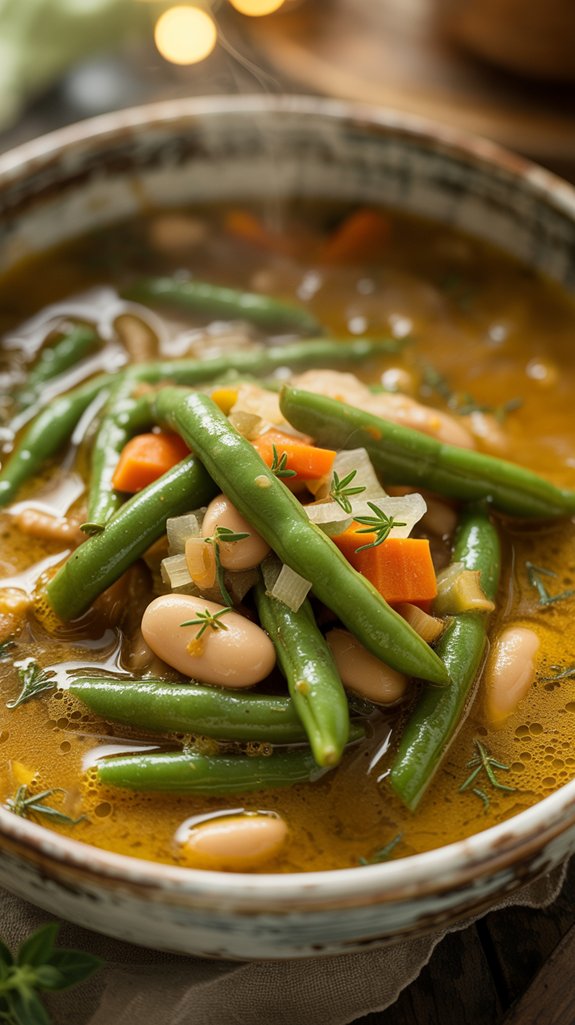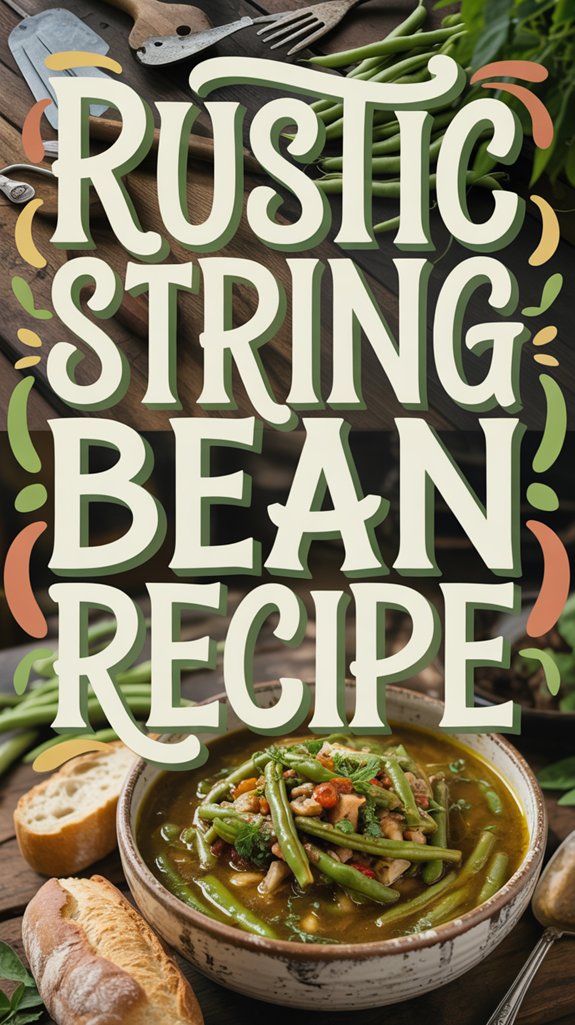Why You’ll Love This this Rustic Garden String Bean Soup
This soup transforms humble garden vegetables into something that tastes way more sophisticated than the simple ingredient list suggests. The magic happens when you puree those tender potatoes, onions, and tomatoes into a silky base that cradles every bite of crisp string beans – it’s like giving your vegetables a warm, flavorful hug. You get all the comfort of a hearty soup without any of the fuss, because honestly, who’s time for complicated recipes when you just want something delicious and satisfying?
Ingredients List
This rustic soup comes together with just a handful of fresh ingredients that you probably already have in your kitchen or can easily grab from any grocery store.
- 1 1/2 quarts water
- 2 teaspoons salt
- 1/2 teaspoon black pepper
- 3 large potatoes, cut into chunks
- 2 large onions, cut into chunks
- 1 large tomato, cut into chunks
- 1 lb fresh string beans, cut diagonally into thin slices
Health Benefits to Feel Good About:
- String beans pack a serious nutritional punch with fiber, vitamins A and C, plus folate
- Potatoes aren’t just comfort food – they’re loaded with potassium and vitamin B6
- Onions and tomatoes bring antioxidants to the party, because who doesn’t want to fight inflammation while slurping soup
- This recipe is naturally low in calories and fat, so you can go back for seconds without the guilt
- Fresh vegetables mean you’re skipping all those mysterious preservatives and additives that come with canned soups
Step by Step Directions

This hearty vegetable soup transforms simple garden ingredients into a satisfying meal through a process of simmering and pureeing that creates a rich, flavorful base.
- Prepare the base vegetables: Bring 1 1/2 quarts of water to a rolling boil in a large pot, then add 2 teaspoons salt, 1/2 teaspoon black pepper, chunked potatoes, onions, and tomato.
- Simmer the foundation: Let the mixture simmer for 30 minutes until the vegetables are completely tender and easily pierced with a fork.
- Cool and puree: Remove the pot from heat and allow the mixture to cool enough to handle safely, then transfer to a food processor and puree until smooth.
- Return and add string beans: Pour the pureed mixture back into the pot and add the diagonally sliced string beans.
- Final simmer: Cook for an additional 10 minutes until the string beans are tender but still have a slight bite.
- Season and serve: Taste and adjust seasoning with additional salt and pepper as needed before ladling into bowls.
Using professional stainless steel cookware ensures even heat distribution throughout the cooking process, preventing hot spots that could scorch your vegetables during the long simmering times.
Substitutions and Variations
- Texture changes: Skip the pureeing step entirely for a chunky, rustic soup, or puree only half the mixture if you want something in between – because sometimes we can’t decide what we want, and that’s perfectly fine.
- Tomato alternatives: Canned diced tomatoes work when fresh ones are out of season, or try roasted red peppers for a completely different flavor profile that’ll make your taste buds wonder what just happened.
Additional Things to Serve With This Dish
This soup practically begs for some crusty bread to soak up every last drop, and honestly, who are we to deny it what it wants?
- Crusty bread or rolls – Because there’s something deeply satisfying about dragging a piece of sourdough through that silky broth, and your bowl will thank you for getting every bit.
- Simple green salad – A basic mix of lettuce, cucumber, and vinaigrette cuts through the soup’s richness without competing for attention, which is exactly what we need here.
- Grilled cheese sandwich – The ultimate comfort food duo that never gets old, no matter how many times people tell you it’s too basic – they’re just jealous they didn’t think of it first.
- Cornbread – Sweet cornbread adds a lovely contrast to the savory vegetables, plus it holds up beautifully when you inevitably use it as a spoon.
- Crackers or oyster crackers – Sometimes you want that little crunch factor without committing to a whole piece of bread, and these small additions deliver exactly that.
- Fresh herbs for garnish – A sprinkle of parsley, chives, or basil on top makes everything look fancy, even when you’re eating it in your pajamas on a Tuesday night.
Cooking Tips & Tricks (Chef’s Notes)
- Save some unpureed vegetables – Blend about three-quarters of your cooked vegetables and leave some chunks for texture, because nobody wants baby food when they’re expecting soup.
- Add beans at the very end – String beans go from perfect to mushy faster than you can say “overcooked,” so treat them like the delicate little things they are.
- Season in layers – Salt at the beginning, taste after pureeing, adjust after the beans go in, because flavors change as everything mingles together.
Nutritional Facts
This hearty vegetable soup delivers substantial nutrition with minimal calories, making it an excellent choice for healthy eating.
- Low calorie density – Approximately 80-100 calories per serving, thanks to the high water content and fresh vegetables.
- High fiber content – String beans and potatoes provide digestive benefits and help you feel satisfied longer.
- Potassium powerhouse – Potatoes contribute significant potassium for heart health and blood pressure regulation.
- Vitamin C boost – Fresh tomatoes and string beans deliver immune-supporting antioxidants.
- Naturally fat-free – Contains virtually no fat unless you add oil or butter during preparation.
- Good source of folate – String beans provide this essential B vitamin important for cell function.
- Complex carbohydrates – Potatoes offer sustained energy without blood sugar spikes.
- Low sodium option – You control the salt content, making it heart-friendly when prepared with less salt.
Fun “Did You Know?”
Ever wonder why string beans got their name? I’ll tell you – older varieties had tough, fibrous strings running along their seams that you’d pull off before cooking.
Modern breeding’s eliminated most of these strings, but the name stuck.
Here’s another fascinating tidbit: string beans are actually immature seed pods we harvest before the beans inside fully develop. If you let them grow, you’d get dried beans instead!
I find it amazing that this simple vegetable belongs to the same family as kidney beans and black beans.
They’re incredibly versatile and pack surprising nutritional power.





